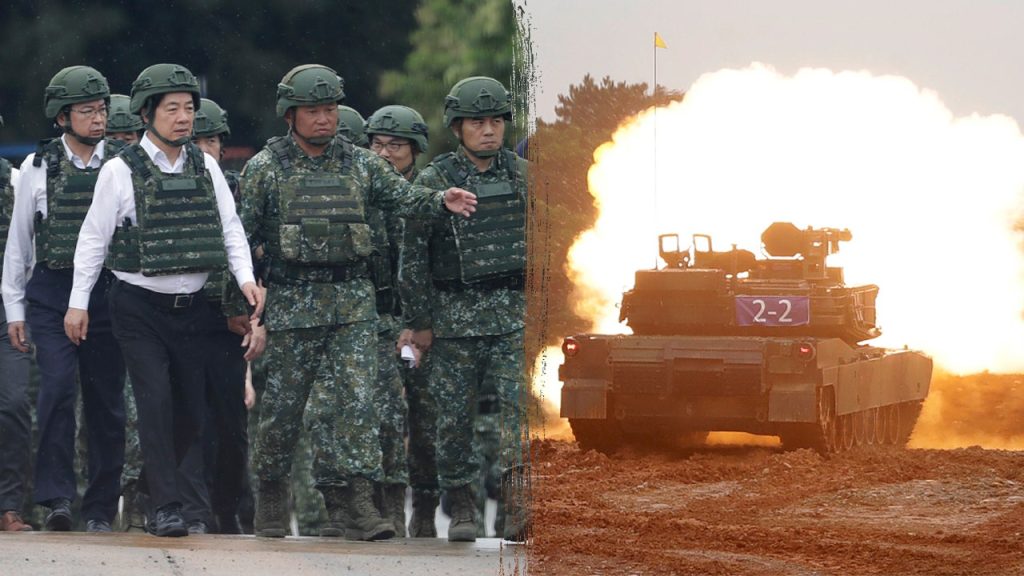Taiwan’s President Lai Ching-te observed the island’s military conducting live-fire drills utilizing U.S.-manufactured Abrams M1A2T tanks on Thursday. These exercises are part of the annual Han Kuang military drills aimed at enhancing Taiwan’s defenses against potential aggression from China. The drills come amid rising tensions in the region, as Beijing has been increasing military pressure on Taiwan, exhibiting its capabilities through near-daily incursions and threats.
| Article Subheadings |
|---|
| 1) Overview of the Han Kuang Drills |
| 2) The Role of U.S. Military Equipment |
| 3) Escalating Tensions with China |
| 4) Taiwan’s Defense Strategy and Global Alliances |
| 5) Future Implications and Regional Stability |
Overview of the Han Kuang Drills
The Han Kuang exercises, which are Taiwan’s most extensive military drills to date, span a full 10 days and involve various military branches demonstrating their combat capabilities. These drills serve a dual purpose: they aim to boost domestic military readiness while conveying a message to both domestic and international observers about Taiwan’s defense capabilities. President Lai Ching-te emphasized the importance of these drills, noting their focus on “large-scale, realistic combat.” The exercises involve not only tank maneuvering but also complex scenarios intended to simulate potential combat situations. The dynamic nature of the live-fire drills indicates an effort to enhance the military’s operational readiness and precision, important aspects when considering the persistent threat from China.
The Role of U.S. Military Equipment
The use of U.S.-made Abrams M1A2T tanks in these live-fire drills represents a significant shift in Taiwan’s military capabilities. Taiwan has recently made a substantial investment in military upgrades, including the procurement of 108 tanks for $1.45 billion. These tanks, combined with advanced weaponry such as F-16V jet fighters and HIMARS missile systems, signify a strategic partnership between Taiwan and the United States. Observations from the drills highlighted the ability of the tanks to engage both stationary and moving targets with 100% accuracy, showcasing enhanced training and proficiency among Taiwanese forces. This partnership not only enhances Taiwan’s defensive posture but also serves as a deterrent against potential aggression from neighboring China, illustrating the U.S.’s commitment to supporting Taiwan’s defense capabilities.
Escalating Tensions with China
The geopolitical climate surrounding the Taiwan Strait remains tense, particularly with China’s increasing militarization and threats. Officials from Beijing have made clear their intent to bring Taiwan under their control, underscoring a willingness to employ force if necessary. Taiwan experiences daily harassment from Chinese military activities, including incursions into its airspace and maritime zones, with military ships and surveillance balloons regularly operating in nearby waters. Officials have articulated a readiness to respond to these provocations, marking a significant moment in cross-strait relations. China’s dismissive attitude towards these military drills, calling them ineffective and a mere show, highlights the deepening divide and mistrust between the two entities.
Taiwan’s Defense Strategy and Global Alliances
The ongoing military exercises and Taiwan’s investment in defense underscore a broader strategy to solidify its position as a formidable entity in the Indo-Pacific region. Taiwan seeks to bolster its alliances with key international partners, notably the United States, which has acknowledged its security as a primary concern. This alliance is crucial for Taiwan as it navigates the uncertainty posed by Chinese aggression. Since the U.S. is Taiwan’s largest supplier of defense technology, the relationship emphasizes a mutual interest in maintaining peace and stability in the region. Consequently, any military resolution must consider the international ramifications, especially regarding U.S. support and military presence in the area, which could deter potential conflicts.
Future Implications and Regional Stability
The developments during the Han Kuang drills not only have implications for Taiwan but also resonate throughout the Indo-Pacific region. As Taiwan continues to upgrade its military capabilities, the potential for conflict with China could escalate, prompting responses from various countries concerned about stability in the region. Should Taiwan’s defense strategies be successful, they may serve as a model for other nations facing similar threats. However, any miscalculation could have significant consequences, given the interconnectedness of regional politics and alliances. The question remains: will Taiwan’s robust military posture deter aggression or escalate tensions further? The outcomes of these exercises could shape the future of cross-strait relations and regional security dynamics significantly.
| No. | Key Points |
|---|---|
| 1 | Taiwan’s live-fire drills showcase military readiness amidst rising tensions with China. |
| 2 | The U.S. continues to play a pivotal role in Taiwan’s defense through military aid and equipment sales. |
| 3 | China’s military provocations are increasing, affecting regional stability. |
| 4 | Taiwan aims to strengthen its alliances with global partners, particularly the U.S., for enhanced security. |
| 5 | The outcomes of military drills may influence the geopolitical dynamics in the Indo-Pacific region. |
Summary
The recent live-fire drills conducted by Taiwan’s military represent not only a show of strength amid heightened tensions with China but also a significant evolution in Taiwan’s defense posture. With advanced U.S. military equipment and strong alliances, Taiwan is attempting to bolster its position in the face of persistent threats. The implications of these exercises extend beyond Taiwan’s shores, signaling the crucial role of global partnerships in maintaining stability in the Indo-Pacific region and raising questions about future engagements with an increasingly assertive China.
Frequently Asked Questions
Question: What are the Han Kuang drills?
The Han Kuang drills are Taiwan’s annual military exercises aimed at enhancing the readiness and capabilities of its armed forces, often in response to regional threats, particularly from China.
Question: Why is U.S. military equipment significant for Taiwan?
U.S. military equipment enhances Taiwan’s defense capabilities and serves as a deterrent against potential aggression from China, emphasizing the strategic partnership between the two entities.
Question: How does China view Taiwan’s military exercises?
China has dismissed Taiwan’s military exercises as ineffective and has reiterated its intentions to unify Taiwan with force if necessary, increasing tensions in the region.


